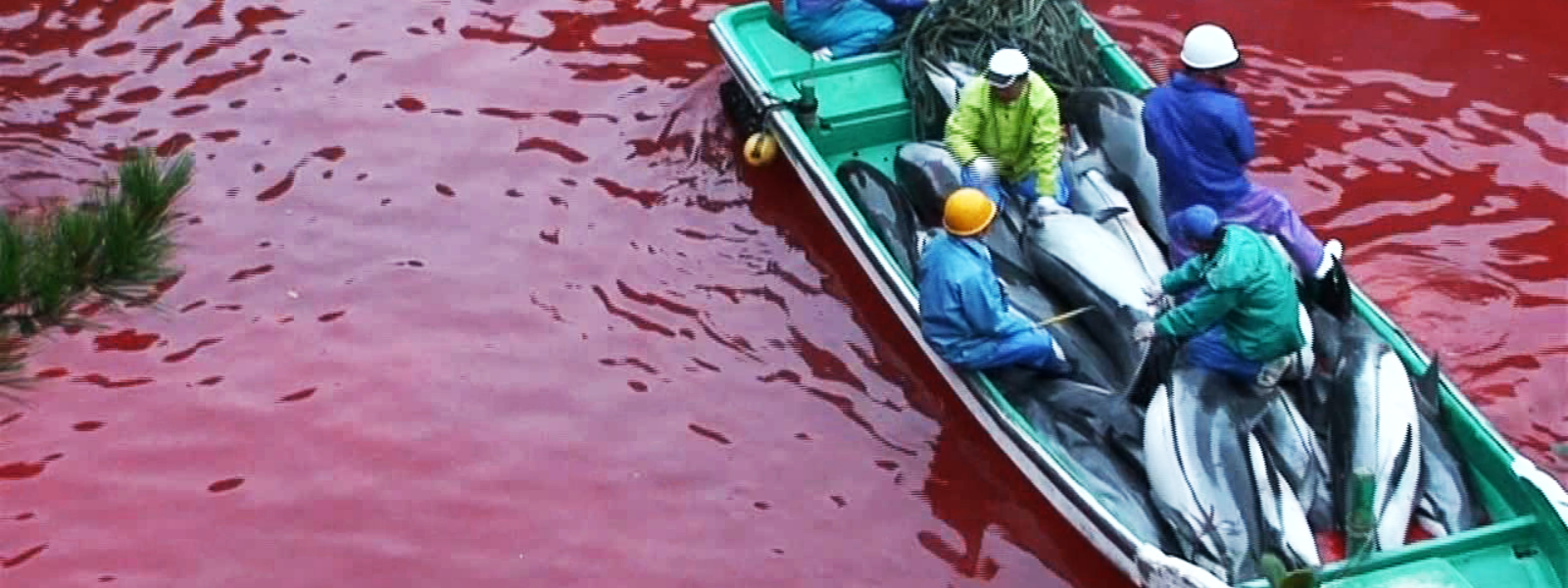

A new season of bloodshed is to begin on Sept. 1st in the small town of Taiji, Japan. The dolphin hunts (depicted in the Academy Award-winning documentary The Cove, which chronicles the efforts of Earth Island Institute to end the hunts) go on for six months, through the end of February, with the seas around the Cove in Taiji turning bright red with blood.
The new quotas for this season, prepared by the Japan Fisheries Agency, which also oversees and promotes Japan’s renewed commercial whaling industry, continue to be higher than the actual catch of dolphins by the Taiji hunters, making a mockery of any science. As the Japan government has never undertaken any research on the status of the dolphin stocks, the quotas are useless for any conservation purpose.
Last season (Sept. 2018 to Feb. 2019) had an overall quota of 2,040 dolphins of nine different species, and 1,162 dolphins were driven into the Cove that season, far below the quota. The total of dolphins killed plus those kept for captivity was 775 dolphins this last season; the balance were herded out of the Cove, but their survival after the trauma of the slaughter of their fellow pod-members is problematic.
Only one species -- Risso’s Dolphin -- came close to meeting the species quota: 142 were killed for meat and 26 were captured for lives in captivity, for a total of 168 animals, still well below the quota of 251. Eight Risso’s Dolphins were released from the Cove, which is not counted against the quota, despite the fact that released animals are likely badly traumatized and weakened from the capture and are unlikely to survive.
The total kill of dolphins amounted to 534 that were slaughtered for meat, despite declining interest in Japan in eating whale or dolphin meat. As has been documented by the International Marine Mammal Project (IMMP) of Earth Island Institute and other organizations, the meat of these dolphins is highly contaminated with mercury, PCBs, and likely radiation from the Fukushima nuclear plant meltdown.
In fact, the killing of dolphins for meat in Taiji has declined virtually every year since IMMP began our Save Japan Dolphins Campaign in 2004. For example, in the 2010-11 season, the hunters killed 849 dolphins. In the 2017-18 season, 610 dolphins were killed. It is likely the hunts for meat will continue to decline, as Japanese young people in particular do not eat whale or dolphin meat.
However, the dolphin hunts continue due to the lucrative captivity industry. Dolphins captured in the hunts that are of “show quality” (e.g. are female and have few blemishes) are trained in various areas of Taiji and then sold on the world market. A trained dolphin can bring as much as $150,000, while a dolphin killed for meat only brings $500 to $600 for the meat. Most Taiji dolphins go to Japanese aquariums and similar facilities in China, while a few wind up in other places like Russia, the Ukraine, and the Middle East.
Last season (2018-19), 241 dolphins were caught for captivity. The main species targeted is the Bottlenose Dolphin, of which 164 were captured for lives in captivity in small tanks. 15 were killed for meat, but the Taiji hunters released 130, again in a vain attempt at conservation. The quota for the species for this coming season remains high, although this year’s quota is down to 298 Bottlenose Dolphins, still higher than the actual catch last season.
A handful of each of the other dolphin species were captured for captivity, despite some being very poor subjects for keeping alive in small tanks.
New quotas for the upcoming season are now out, allowing the slaughter or permanent captivity of up to 1,749 dolphins. While this is lower than last year, the decline in actual captures continues to show the quotas are not working to protect dolphin species of Japan.
The one bright spot is that more and more Japanese young people are protesting whaling and dolphin hunting, even in Taiji itself. They hold great hope for the future of the dolphins of Japan.
Thanks to CetaBase and the organizations and volunteers who provide the information about the number of dolphins in Taiji’s dolphin hunts.
Photo courtesy Oceanic Preservation Society.
Sign our Petition to end the killing of dolphins and whales in Japan.